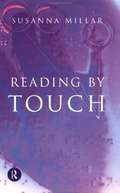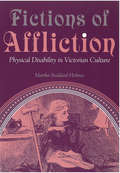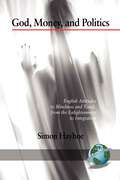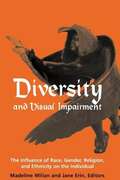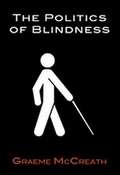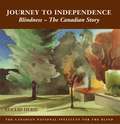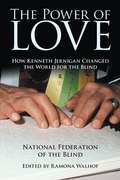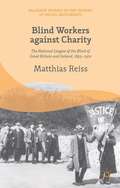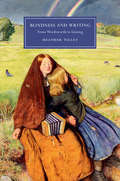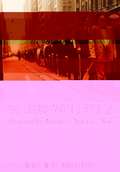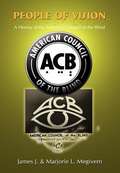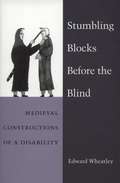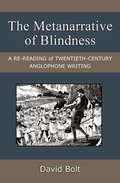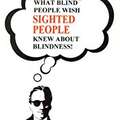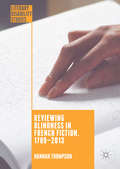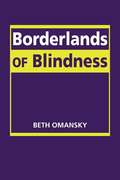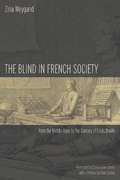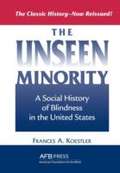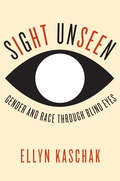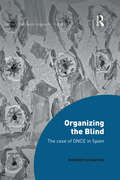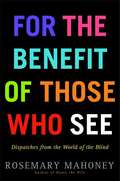Special Collections
Blindness and Visual Impairment Special Collection
Description: A collection featuring biographies, memoirs, fiction and non-fiction by and about members of the blind community. #disability
- Table View
- List View
Reading by Touch
by Susanna MillarThe perceptual, linguistic and cognitive processes involved in sighted reading have been widely studied, but the use of touch raises new issues. Drawing on her research with novice and fluent braille readers, Susanna Millar examines how people initially process braille and how skill with sounds, words, meaning and spelling patterns influence processing. The main focus is on braille, but findings on the "Moon" script, vibrotactile devices, maps and icons are also considered in the context of their practical implications and access to computer technology.
Fictions of Affliction
by Martha Stoddard Holmes"Highly recommended . . . Holmes moves seamlessly from novelists like Charles Dickens to sociologists like Henry Mayhew to autobiographers like John Kitto. " ---Choice "An absolutely stunning book that will make a significant contribution to both Victorian literary studies and disability studies. " ---Rosemarie Garland-Thomson, Emory University "Establishes that Victorian melodrama informs many of our contemporary notions of disability . . . We have inherited from the Victorians not pandemic disability, but rather the complex of sympathy and fear. " ---Victorian Studies Tiny Tim, Clym Yeobright, Long John Silver---what underlies nineteenth-century British literature's fixation with disability? Melodramatic representations of disability pervaded not only novels, but also doctors' treatises on blindness, educators' arguments for "special" education, and even the writing of disabled people themselves. Drawing on extensive primary research, Martha Stoddard Holmes introduces readers to popular literary and dramatic works that explored culturally risky questions like "can disabled men work?" and "should disabled women have babies?" and makes connections between literary plots and medical, social, and educational debates of the day. Martha Stoddard Holmes is Associate Professor of Literature and Writing Studies at California State University, San Marcos.
God, Money, and Politics
by Simon HayhoeHayhoe follows the British progression of the blind as immoral, to the need for rehabilitation, to questions of an educational nature.
Diversity and Visual Impairment
by Madeline Milian and Jane N. ErinA scholarly collection of insightful essays which look at how visual impairment interacts with certain social characteristics to affect human personalities.
The Community of the Blind
by Yoon Hough KimDr. Kim has investigated the validity of the widely-held view that while there are a large number of blind persons whose social lives are centered in the mainstream, that is with sighted persons, there are an equally large number of blind persons whose social lives are restricted mainly to other blind persons.
The Politics of Blindness
by Graeme MccreathThis book provides a rallying cry so that the voice of users of services can be heard, and both the provision of services can be tailored by and shaped to their needs.
The anti-discrimination clause, which I was proud to contribute to in the extension of the Disability Discrimination Act, the creation of the Disability Rights Commission (now part of the Equality and Human Flights Commission) and the Office of Disability inside UK government, has enabled individual and collective experience of inequality and discrimination to be tackled head on.
Undaunted by Blindness
by Clifford E. OlstromThe purpose of this book is to provide concise biographical information about four hundred notable blind persons. The people in this volume are but a small sample of the many thousands of notable blind persons in history.
The Journey to Independence
by Euclid HerieThe Canadian National Institute for the Blind (CNIB) has sought to improve the lives of generations of blind Canadians. Established in 1918, this philanthropic organization has guided blind people out of a time of poverty and abuse, bringing them the same rights and freedoms as all Canadians.
This book explores the history of the CNIB - from the men who crafted its charter to the people who have made it so successful. Millions of Canadians have been touched by the services it provides or by its message of hope. The CNIB has left a legacy in Canada’s legislative, judicial, and cultural fabric, and it is a history that must be told.
The Power of Love
by National Federation of the BlindThe Power of Love: How Kenneth Jernigan Changed the World for the Blind shares the voices of a collection of individuals whose writings reveal the deep truth that serves as the foundation for the life and work of Kenneth Jernigan.
His life and their writings together speak of how Thomas Jefferson's self-evident truths imply that equality extends to embrace blind people just as surely as this country has come to understand equality's inclusion of all people regardless of the color of their skin.
Ramona Walhof, editor of The Power of Love and longtime friend of Kenneth Jernigan, draws together the distinctive voices of individuals who knew Kenneth Jernigan and whose lives he touched through his work with the National Federation of the Blind. Each of the reflections begins with a brief biographical sketch that introduces the chapter's author and ties his or her life to Kenneth Jernigan and his work.
The book concludes with a chapter, "Blindness: The Federation at Fifty," a retrospective written by Kenneth Jernigan himself in the last decade of his life. The Power of Love: How Kenneth Jernigan Changed the World for the Blind gathers a polyphonic chorus of voices that tell how the power of love, coursing through the life of Kenneth Jernigan, changed the world for the blind and, in so doing, changed the world for everyone.
From Homer to Helen Keller
by Richard Slayton FrenchFrom Homer to Helen Keller, Homer stands for the greatest achievement of the blind in the times antecedent to their systematic education. He stands for all those bards, many of them blind or blinded, creators of literature and makers of our language, who through ballads, always of great vigor and sometimes of surpassing beauty, have handed down to us the glorious traditions of far-off heroic times.
Miss Keller stands for the supreme achievement of education. The blind claim her, but the deaf can claim her, too, and modern education can claim her more than either--and all humanity claims her with the best claim of all. For she is the epitome of all that is best in humanity, all that is most spiritual; and all this through conscious aim and directed effort, through education in its best sense.
Blind Workers against Charity
by Matthias ReissThe National League of the Blind was the first radical self-represented group of visually impaired people in Britain, with branches in every part of the United Kingdom. Founded in 1893, it registered as a trade union in 1899 and still exists today as part of the trade union 'community'.
From the very beginning, the League campaigned vehemently to make the state solely responsible for providing training, employment and assistance for the visually impaired as a right. It also fought for the abolition of all charitable aid for blind people and better wages and working conditions in workshops, as well as other issues such as travel or tax concessions.
This book is the first critical study on this unique social movement organisation. It explores the League's multifaceted character, its campaign for 'direct state aid,' its relationship with the trade union movement and the Labour Party, and its impact on the British welfare state.
No Sight - Great Vision
by J. W. WilsonThis text provides a history of the Association for the Blind in Australia.
Cambridge Studies in Nineteenth-Century Literature and Culture
by Heather TilleyIn this innovative and important study, Heather Tilley examines the huge shifts that took place in the experience and conceptualisation of blindness during the nineteenth century, and demonstrates how new writing technologies for blind people had transformative effects on literary culture.
Considering the ways in which visually-impaired people used textual means to shape their own identities, the book argues that blindness was also a significant trope through which writers reflected on the act of crafting literary form.
Supported by an illuminating range of archival material (including unpublished letters from Wordsworth's circle, early ophthalmologic texts, embossed books, and autobiographies) this is a rich account of blind people's experience, and reveals the close, and often surprising personal engagement that canonical writers had with visual impairment.
Drawing on the insights of disability studies and cultural phenomenology, Tilley highlights the importance of attending to embodied experience in the production and consumption of texts.
Veterans with a Vision
by Serge Marc DurflingerDurflinger (history, the University of Ottawa, Canada) chronicles advocacy by Canadian servicemen blinded in war, highlighting their efforts to help Canadian veterans and all blind citizens. The book begins with the establishment of the Canadian National Institute for the Blind in 1918 by 200 Canadian servicemen blinded in WWI, then continues with the formation of the Sir Arthur Pearson Association of War Blinded, which advocated for government benefits, job retraining, and other social programs. Key figures are profiled, and issues such as physical and psychological rehabilitation are discussed. The book is based on archival material from both organizations.
People of Vision
by James J. Megivern and Marjorie L. MegivernPeople of Vision: A History of the American Council of the Blind. The history of the treatment of individuals who are blind by other members of society is fraught with misconceptions, prejudices, myths, and stereotypes.
There are those who believe that blind people are OK as long as they stay "in their place," removed from society. Others feel that blind individuals are helpless and hopeless, deserving only of charity and pity. Still others have the notion that all blind people can be taught certain skills which make them unusually suited to a few specific jobs. The idea that people who are blind are first of all people, capable of and deserving the opportunity to be fully assimilated, fully participating members of society as equals has gained some recognition in certain parts of this country but still has a long way to go.
Stumbling Blocks Before The Blind
by Edward WheatleyStumbling Blocks Before the Blind presents the first comprehensive exploration of a disability in the Middle Ages, drawing on the literature, history, art history, and religious discourse of England and France. It relates current theories of disability to the cultural and institutional constructions of blindness in the eleventh through fifteenth centuries, examining the surprising differences in the treatment of blind people and the responses to blindness in these two countries.
The book shows that pernicious attitudes about blindness were partially offset by innovations and ameliorations---social; literary; and, to an extent, medical---that began to foster a fuller understanding and acceptance of blindness. A number of practices and institutions in France, both positive and negative---blinding as punishment, the foundation of hospices for the blind, and some medical treatment---resulted in not only attitudes that commodified human sight but also inhumane satire against the blind in French literature, both secular and religious. Anglo-Saxon and later medieval England differed markedly in all three of these areas, and the less prominent position of blind people in society resulted in noticeably fewer cruel representations in literature. This book will interest students of literature, history, art history, and religion because it will provide clear contexts for considering any medieval artifact relating to blindness---a literary text, a historical document, a theological treatise, or a work of art.
For some readers, the book will serve as an introduction to the field of disability studies, an area of increasing interest both within and outside of the academy. Edward Wheatley is Surtz Professor of Medieval Literature at Loyola University, Chicago.
The Metanarrative Of Blindness
by David BoltAlthough the theme of blindness occurs frequently in literature, literary criticism has rarely engaged the experiential knowledge of people with visual impairments. The Metanarrative of Blindness counters this trend by bringing to readings of twentieth-century works in English a perspective appreciative of impairment and disability. Author David Bolt examines representations of blindness in more than forty literary works, including writing by Kipling, Joyce, Synge, Orwell, H. G. Wells, Susan Sontag, and Stephen King, shedding light on the deficiencies of these representations and sometimes revealing an uncomfortable resonance with the Anglo-American science of eugenics.
What connects these seemingly disparate works is what Bolt calls “the metanarrative of blindness,” a narrative steeped in mythology and with deep roots in Western culture. Bolt examines literary representations of blindness using the analytical tools of disability studies in both the humanities and social sciences. His readings are also broadly appreciative of personal, social, and cultural aspects of disability, with the aim of bringing literary scholars to the growing discipline of disability studies, and vice versa. This interdisciplinary monograph is relevant to people working in literary studies, disability studies, psychology, sociology, applied linguistics, life writing, and cultural studies, as well as those with a general interest in education and representations of blindness.
What Blind People Wish Sighted People Knew About Blindness! (Revised Edition)
by Harry Martin
Harry Martin became blind as the result of an eye disease he contracted while serving in the Navy in 1973. His eye condition began as a case of severe visual impairment, and progressed to total blindness over a period of twenty years. Harry lives with his wife, Carol, and his guide dog, Frankie in Orlando, Florida.
THIS BOOK IS A MUST READ FOR ALL SIGHTED PEOPLE!
Whether you know a blind person or not, you must read this book. The reader will gain a new understanding of what it is like to be blind, and to go blind. Find out why some blind people can see. Learn how guide dogs work. Discover how blind people do things without sight. If you have a blind relative, friend, spouse, or co-worker; this fascinating book will tell you how to relate to them better. Teachers, this book is an outstanding educational tool. Use it to teach your students all about blindness and the blind.
Reviewing Blindness in French Fiction, 1789–2013
by Hannah ThompsonThis book argues that the most interesting depictions of blindness in French fiction are those which call into question and ultimately undermine the prevailing myths and stereotypes of blindness which dominate Western thought. Rather than seeing blindness as an affliction, a tragedy or even a fate worse than death, the authors examined in this study celebrate blindness for its own sake. For them it is a powerful artistic and creative force which offers new and surprising ways of describing, and relating to, reality. Canonical and lesser-known novels from a range of genres, including the roman noir, science fiction, auto-fiction and realism are analyzed in detail to show how the presence of blind characters invites the reader to abandon his or her traditional reliance on the sense of sight and engage with the world in sensual, and hitherto unexpected, ways. This book challenges everything we thought we knew about blindness and invites us to revel in the pleasures and perils of reading blind.
Borderlands of Blindness (Disability in Society Series)
by Beth OmanskyBeth Omansky explores the lives of people with legal blindness to show how society responds to those who don't fit neatly into the disabled/nondisabled binary. Probing the experience of education, rehabilitation, and work, as well as the more intimate spheres of religion, family, and romantic relationships, her frank and theoretically sophisticated portrait of the legally blind experience offers an insight into our understanding of the social construction of disability.
Now We Are Citizens
by Zina Weygand and Emily-Jane CohenThe integration of the blind into society has always meant taking on prejudices and inaccurate representations.
Weygand's highly accessible anthropological and cultural history introduces us to both real and imaginary figures from the past, uncovering French attitudes towards the blind from the Middle Ages through the first half of the nineteenth century. Much of the book, however, centers on the eighteenth century, the enlightened age of Diderot's emblematic blind man and of the Institute for Blind Youth in Paris, founded by Valentin Haüy, the great benefactor of blind people.
Weygand paints a moving picture of the blind admitted to the institutions created for them and of the conditions under which they lived, from the officially-sanctioned beggars of the medieval Quinze-Vingts to the cloth makers of the Institute for Blind Workers. She has also uncovered their fictional counterparts in an impressive array of poems, plays, and novels. The book concludes with Braille, whose invention of writing with raised dots gave blind people around the world definitive access to silent reading and to written communication.
The Unseen Minority
by Frances A. KoestlerThe book ia a definitive history of the societal forces affecting blind people in the United States and the professions that evolved to provide services to people who are visually impaired.
Sight Unseen
by Ellyn KaschakSight Unseen reveals the cultural and biological realities of race, gender, and sexual orientation from the perspective of the blind. Through ten case studies and dozens of interviews, Ellyn Kaschak taps directly into the phenomenology of race, gender, and sexual orientation among blind individuals, along with the everyday epistemology of vision. Kaschak's work reveals not only how the blind create systems of meaning out of cultural norms but also how cultural norms inform our conscious and unconscious interactions with others regardless of our physical ability to see.
Organizing the Blind
by Roberto GarvíaThis book is a case study which narrates the history of the National Organization of the Spanish Blind (ONCE), established in 1937 during the Spanish Civil War. Contrary to other affluent countries where most blind people live on welfare benefits, the Spanish blind enjoy full employment. Furthermore, the average income of the Spanish blind is higher than that of the sighted. Why is this so? Why the blind, and not the deaf mute, or any other group of disabled people? This book shows that ONCE answers these questions.
The book explains ONCE'S origins, the shifting strategies that the organization has pursued to adapt to an ever-changing environment, its original goals and the way they have mutated and been interpreted, its conflicting relationship with an authoritarian regime, its struggle to find its place in a democratic regime, and its relations with other groups of disabled people. A historical narrative, the book lies at the intersection between disability and organization studies, history and sociology.
It will be of interest to all scholars of disability studies, the sociology of work, the history of medicine and contemporary Spanish history.
For the Benefit of Those Who See
by Rosemary Mahoney"In this intelligent and humane book, Rosemary Mahoney writes of people who are blind .... She reports on their courage and gives voice, time and again, to their miraculous dignity. " --Andrew Solomon, author of Far From the Tree *** In the tradition of Oliver Sacks's The Island of the Colorblind, Rosemary Mahoney tells the story of Braille Without Borders, the first school for the blind in Tibet, and of Sabriye Tenberken, the remarkable blind woman who founded the school. Fascinated and impressed by what she learned from the blind children of Tibet, Mahoney was moved to investigate further the cultural history of blindness. As part of her research, she spent three months teaching at Tenberken's international training center for blind adults in Kerala, India, an experience that reveals both the shocking oppression endured by the world's blind, as well as their great resilience, integrity, ingenuity, and strength. By living among the blind, Rosemary Mahoney enables us to see them in fascinating close up, revealing their particular "quality of ease that seems to broadcast a fundamental connection to the world. " Having read FOR THE BENEFIT OF THOSE WHO SEE, you will never see the world in quite the same way again.
